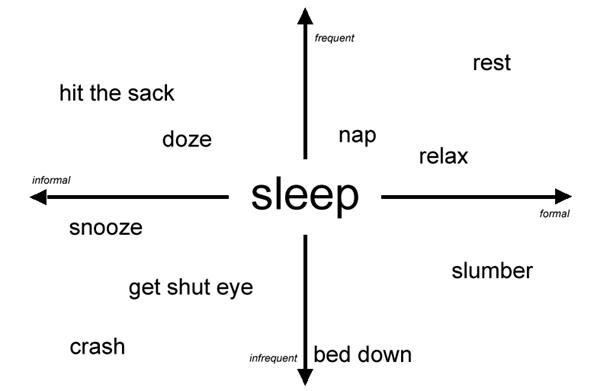3 Activities to Bring Register Into Your Lessons
by Dave Breedlove
 Knowing the register of a word is central to knowing a word. According to Zimmerman (2009), register “is the variation in style that allows us to use language appropriate to a given situation.” This situation is determined by a variety of factors, like relationships between speakers, purpose of interaction, and the setting in which it takes place (Zimmerman, 2009, pp. 95).
Knowing the register of a word is central to knowing a word. According to Zimmerman (2009), register “is the variation in style that allows us to use language appropriate to a given situation.” This situation is determined by a variety of factors, like relationships between speakers, purpose of interaction, and the setting in which it takes place (Zimmerman, 2009, pp. 95).
Despite the multifaceted nature of register, we often teach it in a binary manner. To save already limited time, we tell students that a word is formal or informal. But register goes beyond this, and to teach it as a “this or that” does not prepare students to deal with the countless registers they encounter. How can we help them understand when “yeah” shifts to “yes” and what causes “ma’am” to be attached to that?
One solution is to teach shifting registers. This idea follows Ruhlemann’s (2008) “Register Approach” that sees not one English, but a variety of register-specific Englishes. As previously mentioned, which register is appropriate depends on a number of factors. And a change in any one of these may cause a shift.
The activities presented here were made in order to help students deal with register and its shifts. And, as class time is scarce, they are meant to be included in other lessons. Presented along the lines of the “Three P’s” of presentation, practice, and production, they aim to provide comprehensible input for students as well as give them a chance to produce across registers.
Presentation: Noticing Different Englishes
Students need to be equipped with the tools to recognize or notice the register of an English. The presentation phase of a lesson is an ideal place to introduce and use these noticing skills. The first use of this activity might be a bit register-heavy, but subsequent uses can be incorporated into lessons while taking only minimal time.
In a lesson where some form of media is being presented (like a video clip or a text), ask students to note context details, like the setting and relationship of the speakers. Follow this with a class discussion of what the students noticed, while writing key points on the board. Then ask the students to decide the register of the media piece. At first, using the binary formal-informal may help ease the students into the idea. Later, as they become familiar with cues like setting change, the class can move away from this binary view to one where registers are closer to shades of formality with numerous variations.
Next, replay the clip or have students reread the text after asking them to pay attention to the language used. This can have a vocabulary focus or include pronunciation aspects, like intonation. After the second viewing, use class discussion to elicit the student noticings and relate them to the previous register notes on the board. What words stood out? How do the context details affect word choice? What words only work with this register?
This activity can help raise awareness of what makes up an English or register. Over time, it can also help raise awareness of the fuzzy boundaries between registers, and the word banks and registers generated by the students can be used in the following activities.
Practice: Mapping Shifting Register
This practice activity can be brought into any lesson with an already planned vocabulary focus. It helps the students frame vocabulary in register while giving them a chance to negotiate their own understandings of words. It also gives a visual representation to shifts in register.
First, using selected vocabulary, have students discuss their meanings and create short synonym lists for each word. Then introduce Crovitz and Miller’s (2008) idea of a Synonym Map. A target word is placed at the center of an x-axis and y-axis—in Figure 1, the x-axis represents formality and the y-axis association or frequency of use. Synonyms are placed around the word, shifting in direction depending on their formality and association or frequency.

Figure 1. A Synonym Map
This activity will have students negotiating the meaning of each word as they decide where along the map it should be placed. And the map itself will show that register is not a neat dichotomy but instead a spectrum. A shift in any direction may raise the usefulness of a word while lowering the rest, but it may not completely exclude them.
Production: From Role-Playing to Playing With Roles
Role-plays are an ideal place to let students experiment with shifts in register. In any role-play activity, simply changing one or more details can easily cause the register to shift. As students build an awareness of register, including register shifts in role-plays can allow them the opportunity to test their knowledge. To illustrate this, I will describe a role-play activity I used in class that used shifting register. The students had been learning how to make complaints in English, and I felt this was an ideal setting for shifting registers.
The first setting of this role-play was an average restaurant. I assigned each member of small groups a role—some were patrons and some were wait staff. Then I tasked them with making a complaint about the food and reminded them to use the vocabulary discussed in an activity similar to the previously explained presentation phase. They had to decide which words fit in this particular register.
As language students around the world are familiar with role-play, they finished quickly. After a few groups replayed their skits for the class, I told them they would do it again. But this time, the register was shifted slightly: They were now in a 5-star restaurant and were making a complaint to the manager. This had them discussing what words to change and which words no longer fit in the new register.
For a third time, I shifted register again: this time they were eating at home with their grandmother and had to make a complaint about her home cooking! This moved the register to a different area and had them carefully navigating the meanings of words and their associations.
Each of these role-plays had the same essential task: to complain about food. But by shifting roles and settings, students had to shift their register and negotiate the new meanings and uses of words. Their new roles and new settings had them discussing why they were making changes. It also reinforced the awareness gained by the presentation and practice activities.
This way of shifting register can be incorporated into almost any role-play activity. Here are a few that work well:
- Students tasked with a role-play about being lost can learn to work with register shifts by changing the setting from their hometown to a big city to the jungle.
- Business-themed role-plays can deal with shifts by changing roles as a boss can become an employee while an intern can be promoted to boss.
- Even introductions can help students shift register by changing to whom they are introducing themselves—moving between friends, teachers, and children will have students thinking about different vocabulary and grammar use.
These activities were designed to raise student awareness of the shifting registers they will encounter daily. The activities will also have students working together as they build the skills necessary to adapt to these register changes. And finally, these activities can create a lively atmosphere where students can have fun creating meaning.
References
Crovitz, D., & Miller, J. A. (2008). Register and charge: Using synonym maps to explore connotation. English Journal, 97(4), 49–55.
Ruhlemann, C. (2008). A register approach to teaching conversation: Farewell to standard English? Applied Linguistics, 29(4), 672–693.
Zimmerman, C. (2009). Word knowledge: A vocabulary teacher's handbook. Oxford, United Kingdom: Oxford University Press.
Dave Breedlove recently graduated from Cal State Fullerton’s TESOL program. Before joining the program, he worked as an EFL teacher in a South Korean high school for 1 year. Following that, he was an EFL lecturer at a Chinese university for 3 years. His main teaching interests are pronunciation instruction and the social dynamics of learning.